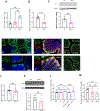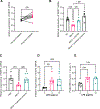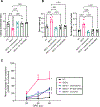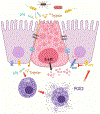Mucosal Serotonin Reuptake Transporter Expression in Irritable Bowel Syndrome Is Modulated by Gut Microbiota Via Mast Cell-Prostaglandin E2
- PMID: 35167867
- PMCID: PMC9117493
- DOI: 10.1053/j.gastro.2022.02.016
Mucosal Serotonin Reuptake Transporter Expression in Irritable Bowel Syndrome Is Modulated by Gut Microbiota Via Mast Cell-Prostaglandin E2
Abstract
Background & aims: Increased colonic serotonin (5-HT) level and decreased serotonin reuptake transporter (SERT) expression in irritable bowel syndrome (IBS) may contribute to diarrhea and visceral hypersensitivity. We investigated whether mucosal SERT is modulated by gut microbiota via a mast cell-prostaglandin E2 (PGE2) pathway.
Methods: C57Bl/6 mice received intracolonic infusion of fecal supernatant (FS) from healthy controls or patients with diarrhea-predominant irritable bowel syndrome (IBS-D). The role of mast cells was studied in mast cell-deficient mice. Colonic organoids and/or mast cells were used for in vitro experiments. SERT expression was measured by quantitative polymerase chain reaction and Western blot. Visceromotor responses to colorectal distension and colonic transit were assessed.
Results: Intracolonic infusion of IBS-D FS in mice caused an increase in mucosal 5-HT compared with healthy control FS, accompanied by ∼50% reduction in SERT expression. Mast cell stabilizers, cyclooxygenase-2 inhibitors, and PGE2 receptor antagonist prevented SERT downregulation. Intracolonic infusion of IBS-D FS failed to reduce SERT expression in mast cell-deficient (W/Wv) mice. This response was restored by mast cell reconstitution. The downregulation of SERT expression evoked by IBS FS was prevented by lipopolysaccharide (LPS) antagonist LPS from Rhodobacter sphaeroides and a bacterial trypsin inhibitor. In vitro LPS treatment caused increased cyclooxygenase-2 expression and PGE2 release from cultured mouse mast cells. Intracolonic infusion of IBS-D FS in mice reduced colonic transit, increased fecal water content, and increased visceromotor responses to colorectal distension. Ondansetron prevented these changes.
Conclusions: Fecal LPS acting in concert with trypsin in patients with IBS-D stimulates mucosal mast cells to release PGE2, which downregulates mucosal SERT, resulting in increased mucosal 5-HT. This may contribute to diarrhea and abdominal pain common in IBS.
Keywords: Colonic Mucosa; IBS; Mast Cells; SERT.
Copyright © 2022. Published by Elsevier Inc.
Conflict of interest statement
Conflicts of interest
The authors disclose no conflicts.
Figures






Comment in
-
Disruption of the Mucosal Serotonin Reuptake Transporter (SERT) Through Gut Dysbiosis.Gastroenterology. 2022 Jun;162(7):1833-1834. doi: 10.1053/j.gastro.2022.03.029. Epub 2022 Mar 24. Gastroenterology. 2022. PMID: 35341788 No abstract available.
References
-
- Dunlop SP, Coleman NS, Blackshaw E, et al. Abnormalities of 5-hydroxytryptamine metabolism in irritable bowel syndrome. Clin Gastroenterol Hepatol 2005;3:349–357. - PubMed
-
- Atkinson W, Lockhart S, Whorwell PJ, et al. Altered 5-hydroxytryptamine signaling in patients with constipation- and diarrhea-predominant irritable bowel syndrome. Gastroenterology 2006;130:34–43. - PubMed
Publication types
MeSH terms
Substances
Grants and funding
LinkOut - more resources
Full Text Sources
Medical
Research Materials

